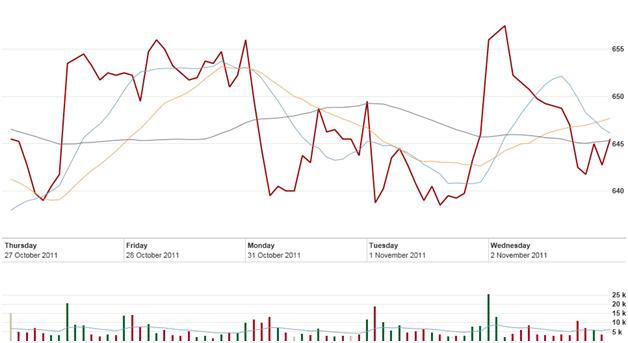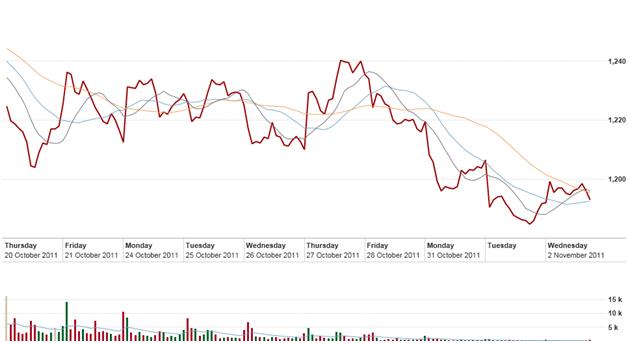This Week’s Experimental Strategies:
- Picking up on our TA Andrew’s advice, I decided to actively incorporate Commitments of Traders (COT) into my strategy
- Decided to learn about Moving Average Convergence/Divergence (MACD)
October 31
Strategy: coming off the weekend there was no major news or changes to technical analysis, but based on dramatic price decreases of overnight trading I decided to go short on 4 contracts of soybeans which resulted in profit.
November 1
Monday Night research
Fundamentals:
Soybeans: – American dollar gained strength; while good weather forecasted for Argentina and Brazil crop planting (Intertemporal Law of One Price).
Telvent DTN Daily Market Commentary: “The direction of outside markets could be central to the grains Tuesday. If the MF Global situation has indeed calmed down, buyers may be back in the markets.”
Technical Analysis: Continuing my tracking of the Corn-Wheat spread showed prices seems to be in range where it likes to be: 18.8 cent difference.
Strategy: prior day open interest was only 19404 down significantly from Friday’s open interest of 34,520. Furthermore, as of Oct. 25, non-commercial commitment of traders was 12209 short positions versus commercial commitment of 20405 long positions. The smartest play seems to be to offset my open soybean and wheat contracts.
November 2
Tuesday Night research
Decided to learn about Moving Average Convergence/Divergence (MACD)
Then visited a new charting site where I overlaid the MACD oscillator against closing prices of soybeans along with the MACD histogram.
The charts indicated a downward trend but a possible rally soon, so I turned to the COT and simple moving averages:
Strategy: Open contracts seemed to be mostly long positions held by large (non-commercial) traders and as we are approaching the expiry date for soybeans I predicted they would have to offset soon so I went short for 3 contracts. Originally I planned on using 18 day moving average as resistance as my bid price, but tweeting with Hossein (who correctly predicted soybeans would rally) raised some doubts in my mind so I used the overnight trading high price as my bid. In retrospect somewhere between my original bid price and my actual bid price would have been optimal.
November 3
Wednesday night research
Fundamentals:
Telvent DTN Daily Market Commentary: + strong export and sales of soybeans were expected
http://www.pitnews.com/marketwrapup.htm: bearish bias for both corn and wheat based on technical analysis.
My own charting indicated that:
- The gap between wheat and corn seems to be too wide. The next step is to figure out whether the corn and wheat will raise or fall tomorrow. Overnight trading showed the price of corn falling while the price of wheat was rising.
- In the messy chart below (sorry!):
- The dark red jagged line is wheat; the light blue jagged line is corn; the smooth purple line is the 40 day simple moving average; the smooth pink line is the 20 day simple moving average; the smooth orange line is the 10 day simple moving average.
- Wednesday’s situation: 40 day SMA is over 20 day SMA and both were trending down; the 10 day SMA looks like it might be trending up but is above corn which is above wheat. (sorry for the poor resolution of graphs but UBC.blogs wouldn’t load the images i copied and pasted directly into my post properly past this point so i had to convert to jpg and upload)
In the charts below I look only at corn:
Strategy for corn: go short corn for 1 contract using between 20 and 10 day SMAs as my bid price.
Strategy for soybeans: Price is between the 10 and 20 day SMAs while the 10 day and 40 day SMAs have converged; the former seems like it might cross above the latter. This suggests that price will rise but I am somewhat hesitant that it a repeat of Monday October 24 (above) will occur where prices rose, then fell and rose again. Going to assume bid below the 20 day SMA go long in case prices do end up raising this will offset the losses I will incur from my open short contracts.
Results
Corn: I totally misread my technical analysis manual I should have went long but I should have went long on corn instead of short. However, outside markets where news that Greece would not have a referendum sparked a rally.
Soybeans: My fat fingers somehow entered my bid as 1868.9 instead of 1186.9 which I then copied and pasted into my audit form. This would have incurred me about a $6/bushel lost on 15,000 bushels. Great thanks to our understanding and generous TAs, Andrew and Javier, for showing mercy when I noticed my mistake and contacted them immediately. Even though I failed to enter the market and made a loss on open short contracts, I still avoided a $100k loss in one day because of a careless mistake.
November 4
Thursday night research
Fundamentals:
- I think tomorrow’s non-farm payrolls will play a significant role and predictions seem to indicate an increase in employment but this information has probably be priced into the market already especially since the expected increase is not substantial.
- My RSS subscription to Financial Times (www.ft.com) did not deliver any earthshaking news
- Overnight trading prices show decreases for all three commodities
Strategy: after yesterday’s careless mistake, I’ve decided to play it safe and offset all of my open contracts.
| Daily Profit Summary | ||||||||||
| Market Open: Open Contracts | New Contracts | Market Close: Open Contracts | ||||||||
| Date | C | S | W | C | S | W | C | S | W | Net Profit |
| Oct-31 | 0 | 0 | 2 | 0 | 4 | 0 | 0 | 4 | 2 | 3920 |
| Nov-01 | 0 | 4 | 2 | 0 | -4 | -2 | 0 | 0 | 0 | 1560 |
| Nov-02 | 0 | 0 | 0 | 0 | 3 | 0 | 0 | 3 | 0 | 1035 |
| Nov-03 | 0 | 3 | 0 | 1 | 0 | 0 | 1 | 3 | 0 | -4200 |
| Nov-04 | 1 | 3 | 0 | -1 | -3 | 0 | 0 | 0 | 0 | 750 |




Hey Nick, your blog seems to be always professional, quite clear and especially the diagrams and charts which are easy to read and understand, and really enjoy the format and your strategies…
Perfect as always!
could you give me some explanation on COT? Or introduce a source about that.